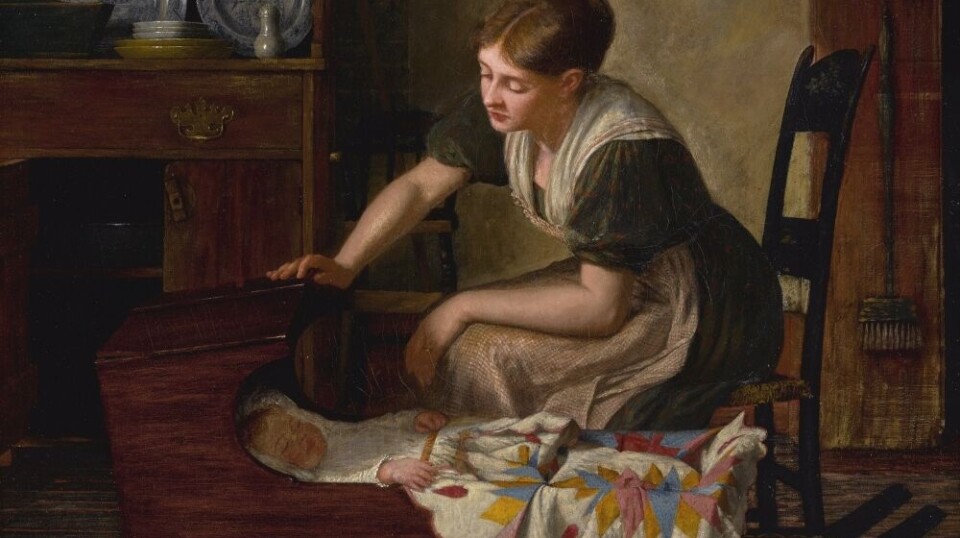THIS CONTENT IS BROUGHT TO YOU BY University of Oslo - read more
Lullabies are not as innocent as people think
The lyrics can address topics such as dead children and unfaithfulness.

'What was the need for you, little friend, my dear boy, my beloved son? For me – a girl, a foolish soul, a mother without a wedding ring?'
This lullaby from Slovenia is one of many studied by musicologist Stephane Aubinet. He researchers lullabies.
It also exemplifies how a lullaby can be so much more than just a soothing song. Not all of them contain sleep-inducing content.
“We often associate lullabies with gentle melodies and innocent lyrics meant to calm children down. However, there's a vast variation: from those that are cheerful and harmonious to songs with morbid and violent lyrics," he says.
Aubinet explains that the Slovenian lullaby is about a young single mother singing to an unwanted child born out of wedlock.
"It represents a form of lament that's fairly common,” he says.
One of the most disturbing lullabies he has come across is Norwegian and goes like this:
'If the child will not sleep, we just take it by the leg, and hit it against the wall, and then the child will sleep.'
Are lullabies universal?
Aubinet has cast a wide net in his investigation, gathering as much literature as possible on lullabies and bedtime songs.
From the earliest recorded lullaby dating back to 2000 BCE in ancient Mesopotamia, to today's modern innovations, such as apps offering ‘soothing sounds and lullabies for toddlers’ in the App Store.
The Spanish poet Rodrigo Caro (1573–1647) described lullabies as "the mother of all songs, and the song of all mothers."
One question Aubinet has pondered is: Are lullabies universal?

“There's significant discourse surrounding the idea that lullabies might be a form of primordial music. I conducted a study of 124 cultures and found that in 97 per cent of these cultures, song was used to help children sleep,” he says.
Only 78 per cent of the cultures had a specific repertoire labelled as lullabies. The others utilised everything from popular music to religious songs, improvisation, and humming.
A timeless theme that recurs in lullabies across all cultures is, unsurprisingly, sleep and nighttime peace.
An 3,000-year-old song from the Indian scripture Rigveda is about how now the mother, father, dog, and all relatives must sleep. According to Aubinet, it is not so different from the Norwegian lullaby So ro lillemann.
“It's also common for the song to have religious content and resemble a prayer," he says.
Who is the song being sung to? Is it the child, or God, or a saint meant to protect the child? It's not always clear, says Aubinet.
The Sámi create individual songs for their children
Aubinet’s interest in this genre stems from his earlier research on joik, which led him to discover a musical tradition among the Sámi known as dovdna.
This practice involves giving each child their own unique melody.
“Dovdna can be used in various contexts, not just to lull a child to sleep. When performed, it's sung slowly and softly. However, it can also be sung more quickly to motivate the child. The purpose may also be to reinforce specific qualities,” he says.
Aubinet has found similar traditions of individual songs among Inuit cultures in Alaska, Canada, Greenland, and among indigenous peoples in Siberia.
“It's an Arctic phenomenon. The Sámi I've interviewed have stated that they compose dovdna because it's important for the child to develop a sense of self and identity, fostering pride in who they are,” he says.
Culture is reflected in the songs
Aubinet shares that in Belgium, where he comes from, most lullabies are cheerful and hopeful. This pattern is typical for many Northern and Western European countries.
“Context and culture play a significant role in the content. In the 19th century, lullaby lyrics in Western Europe became increasingly gentle and sweet. This reflects a new, romantic view of children as innocent beings that needed to be protected with harmonious sounds and words," he says.
This led to the creation of some of our most famous lullabies, including Brahms’ Wiegenlied Opus 49, which can be found on countless music boxes.
In contrast, there is a particular type of lullaby from Japan dating back to the early 20th century. These songs were created by young girls from poor backgrounds who worked as nannies in wealthy families. Living under harsh conditions, they used their songs to express their frustration:
'If the child cries, I will put it in a straw bag, which I will throw into the water deeper than the sea, I will set fire to the bottom with oil to kill it,' one of the songs states.
Lullabies about death
Even if the lyrics are upsetting, the melodies can be calming.
Aubinet believes we may easily be swept away by the rocking rhythm and overlook the meaning behind the words.
One of the most well-known and popular lullabies is Rock-a-bye Baby. It tells the story of a child hanging in a cradle on a tree branch. The branch then breaks, and the child falls.
In Russia and the Baltic countries, it is not uncommon to find lullabies that describe the child’s funeral in detail.
Aubinet is not the only one to have asked: why sing about funerals?
One hypothesis among Russian researchers is that by singing about the funeral, death is tricked into thinking there is no point in visiting. The child is already dead, after all.
“There's a strong analogy between sleeping and being dead. This was especially true in the past when child mortality rates were high. In Greek mythology, Hypnos (sleep) and Thanatos (death) were twin brothers,” he says.
Lullabies for kings
Children are not the only ones who have been lulled to sleep by song. Around the world, there are also examples of kings and other rulers who have dozed off to the melodies of their servants.
A self-biography written by the musician Ṣafī al-Dīn al-Urmawī from the 13th century reveals that if one’s talent is great enough, a lullaby can even save lives and provide new opportunities.
“Baghdad was besieged by Mongols who demanded complete submission from the populace. Ṣafī al-Dīn al-Urmawī was captured and asked if he had any talent, as it might save his life. He replied that he could sing in a way that would make people fall asleep. The Mongol ruler Hülegü asked him to prove it, and indeed, he fell sound asleep,” says Aubinet.
Singing sheep and snakes to sleep
Aubinet has also tried to take a peek into the animal kingdom, pondering whether they have any lullabies of their own.
He suggests that the purring of cats could serve as an example.
However, aside from a few studies on squirrel monkeys that make specific sounds when their offspring are about to sleep, there is limited research in this area.
He has found more literature on humans singing to animals.
“In some cultures in Mongolia and other parts of Asia, lullabies are sung to sheep. Meanwhile, in 19th-century Scotland, there existed a practice known in Gaelic as 'taladh bleoghain,' which refers to songs meant to soothe cattle or other livestock,” he says.
Lastly, he notes that the act of lulling animals to sleep is a widespread theme in mythology. For instance, there is the tale of King Gunnar, who, according to the Völsunga Saga, played sleep-inducing music to snakes to avoid being bitten.
Reference:
Aubinet, S. Lullabies and Universality: An Ethnographic Review, Cross-Cultural Research, vol. 58, 2024. DOI: 10.1177/10693971241272406

This content is paid for and presented by the University of Oslo
This content is created by the University of Oslo's communication staff, who use this platform to communicate science and share results from research with the public. The University of Oslo is one of more than 80 owners of ScienceNorway.no. Read more here.
More content from the University of Oslo:
-
New, worrying trend among incels, according to researcher
-
Ship’s logs have shaped our understanding of the sea
-
New study: The dilemma of copyright in the Global South
-
How your lifestyle affects your risk of bowel cancer
-
Muslims were pagans, according to the Norse sagas
-
How a researcher is working to preserve Arabic music




































